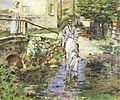Theodore Robinson
Theodore Robinson (born July 3, 1852 in Irasburg , Vermont , † April 2, 1896 in New York City ) was an American painter, known for his Impressionist landscapes. He was one of the first American artists to take up Impressionism in the late 1880s, visiting Giverny , and developing a close friendship with Claude Monet . Many of his works are considered masterpieces of American Impressionism.
Education and early career
Robinson was born in Irasburg, Vermont. His family moved to Wisconsin and Robinson briefly studied art in Chicago . In 1874 he traveled to New York City to attend classes at the National Academy of Design and the Art Students League . In 1876 he traveled to Paris to study under Carolus-Duran and, at the École des Beaux-Arts , with Jean-Léon Gérôme . He exhibited his first paintings in Paris in 1877 and then returned to America for several years in 1879. During this time, Robinson painted in a realistic way, loosely painted but not yet impressionistic; he often depicted people in quiet domestic or agricultural activities.
Robinson in Giverny
Robinson returned to France in 1884, where he would live for the next eight years, visiting America only occasionally. Robinson moved to Giverny , which, under the influence of Claude Monet, became a center for French Impressionist painting. Historians are unsure when Robinson met Monet, but by 1888 their friendship was strong enough for Robinson to move to the famous Impressionist's neighborhood. Robinson's art shifted to a more classic impressionist fashion during this period, likely as a result of Monet's influence. While a number of Americans gathered in Giverny, no one was as close to Monet as Robinson. Monet offered advice to Robinson, as well as soliciting Robinson's opinion on Monet's own progressive work.
Robinson painted at Giverny what historians consider to be some of his best work. They depict the surrounding landscape in different weather conditions, painted in the open air, sometimes with women in quiet postures. An example of his mature work during this period is La Débâcle (1892) in the collection of Scripps College, Claremont, California.
Return to America
Robinson left France and Monet for good in 1892. After returning to America, he stayed for a while in Napanoch, New York, a small town near the Catskill Mountains , where he painted several canal scenes. With New York City as a base, Robinson circled a growing number of American artists and carried on Impressionism. He was particularly close to John Henry Twachtman and Julian Alden Weir and spent much of his time in the nearby artist colony in Cos Cob School, Connecticut. There he painted a number of boat scenes at the Riverside Yacht Club that are considered some of his best work.
Last years
Even though his reputation as a major American impressionist grew, Robinson still needed help to learn something. He also had doubts about the quality of his work. His career and life ended unexpectedly in April 1896 with a fatal asthma attack in New York City.
Today Robinson's paintings can be found in the collections of many major museums, such as the Metropolitan Museum of Art in New York City, the National Gallery of Art , Washington, DC, and the Art Institute of Chicago . In Germany the North Frisian Museum preserves . Nissenhaus Husum on the landscape Mount Solaro, Capri .
Works
literature
- William H. Gerdts: American Impressionism . 2nd Edition. Abbeville Press Publishers, New York 2001, ISBN 0-7892-0737-0 .
- Susan G. Larkin: The Cos Cob Art Colony . National Academy of Design, New York 2001, ISBN 0-300-08852-3 .
Web links
- Works by Theodore Robinson at Zeno.org .
- Theodore Robinson Biography and Images: Hollis Taggart Galleries
- A Pioneer of American Impressionism
| personal data | |
|---|---|
| SURNAME | Robinson, Theodore |
| BRIEF DESCRIPTION | American painter |
| DATE OF BIRTH | July 3, 1852 |
| PLACE OF BIRTH | Irasburg , Vermont |
| DATE OF DEATH | April 2, 1896 |
| Place of death | New York City |
















